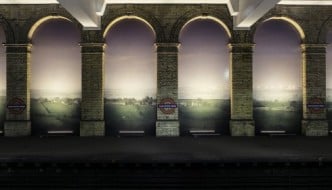
The Millennium Bridge got off to a wobbly start, literally: it was known for its excessive wobbling
When we think of iconic landmarks in London, a lot of older buildings come to mind. There’s the Big Ben clocktower and the Houses of Parliament, there’s Westminster Abbey, there’s St. Paul’s Cathedral…. Really, the only newer one that tends to be in the conversation is the London Eye, which was built in 1999 and stands out, understandably, because it’s a giant Ferris wheel that towers over the skyline. But for the most part it’s the older landmarks that define the city.
One newer structure aside from the London Eye has also managed to achieve something close to iconic status, however, and has done so in under 18 years. We’re referring to the Millennium Bridge, which, with its connections to art, engineering, and its own unique history, has already become part of the London culture.
From the beginning, this was a different sort of building project for the London area. That’s because it typically requires an Act of Parliament (seriously) for a new bridge to be built over the Thames. The river, particularly as it passes through London, is heavily protected as a part of the cityscape, so it is not made easy for developments to take place there. The Millennium Bridge, however, was allowed via the Port of London Authority so that it could be built quickly to commemorate the beginning of the new millennium in the year 2000.
The development of the bridge was also somewhat different in that, like a surprising number of iconic structures built throughout human history, it came about as a result of a public lottery system. Specifically, it was funding from the Heritage Lottery Fund that helped the city to put this project together and have the bridge ready for the beginning of the new millennium.
Despite successful permission and funding, the bridge did not get off to a good start. It was known, early on, as the “Wobbly Bridge,” because it was quite literally wobbling. This, combined with the fact that it’s a suspension bridge suspended from below, such that there is nothing to provide you with perspective or balance overhead, made it an uncomfortable structure to walk across for some. However, the problems were ultimately fixed, and in the end this shaky beginning only seems to have made the “Wobbly Bridge” more famous.
Now, people appreciate the bridge fully for what it is. As a piece of the city it’s an artful and practical addition, built to provide a head-on, spectacular view of St. Paul’s Cathedral from across the Thames (and as you walk toward it). The bridge is also home to over 400 mini-artworks, courtesy of “The Chewing Gum Man,” an innovative street artist who turns other people’s discarded gum into bright, colorful art. And last but not least, the Millennium Bridge has also already been featured in a number of different films – most notably Guardians Of The Galaxy and Harry Potter And The Half-Blood Prince.
All of this intrigue makes this bridge an iconic piece of London art and culture, just 18 years into its existence. It’ll be incredible to see what more happens with it in the years to come.




Comments